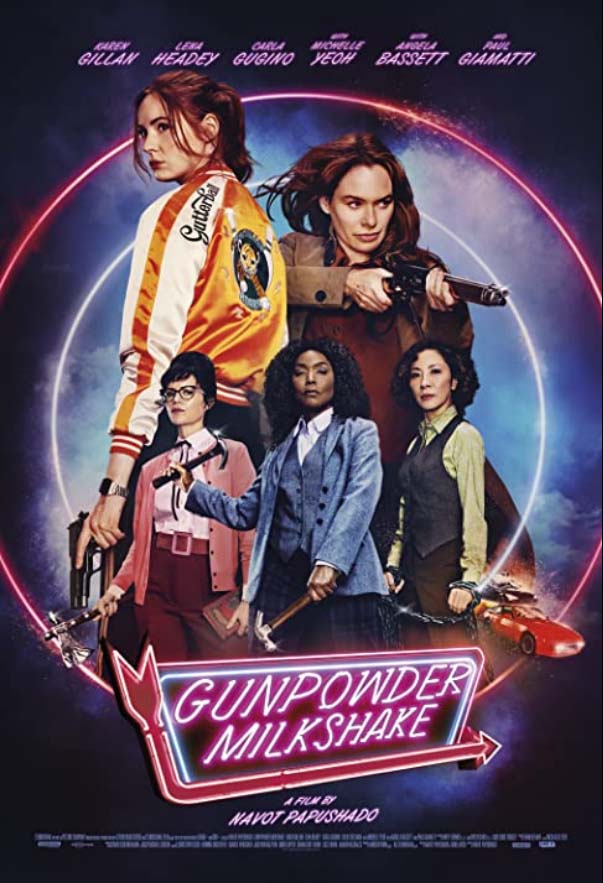There’s a bowling alley sequence in the early parts of “Gunpowder Milkshake” that sets up the full gamut of the tedium which will soon come to represent the film. Sam is an assassin who works for a mysterious body – ‘The Firm’. She runs afoul of a mob boss when her handler, Nathan, gives her some shoddy information. For reasons unclear, she’s made liable for this mistake and he sends three inept goons to subdue her.
First come the generic dialogue to set this up – the three goons somehow see Sam’s femininity as a strike against her despite her position as a trusted assassin. It’s unclear why, since she seems to have a good reputation at her job. Nonetheless, she plays into it. Mariachi music begins to play with the accompanying lyrics ‘We can fight, fight, fight.’ We hear the pronounced sounds of bones cracking as the players get into position. The camera moves slowly, observing the fight. It’s an oddly choreographed one—everything seems to be moving in an odd kind of staccato convulsion as Sam and her assailants seem to be enacting a choreographed dance rather than naturally extending their bodies as weapons. No one breaks a sweat, although the sounds of bones crushing suggests exertion. Blood seems to haphazardly appear, incongruous with where – and how – the punches have been thrown. The sequence is lit in neon, occasionally cutting to security cameras showing everything in blue as another team of adversaries observe the show.
The fight does not really serve to illuminate our understanding of these characters. Sam wins the fight, of course. She has to. She is our protagonist. But it’s hard to discern whether it is due to her resourcefulness or a compulsion of the plot. Karen Gillan is playing Sam as a detached loner, but she feels strangely lifeless in a performance which deflates the energy. If fight sequences serve to deliver an understanding of character and space on screen, it’s hard to recognise beyond the alleys in the background what the physical construction of this place is or what Sam’s perspective on the movement of her body is. Things are happening but to what end? And to whom? And beyond those questions – why does it all look so ugly?
It’s easy to place where Navot Papushado (directing a script he co-writes with Ehud Lavski) is drawing influence from. But it’s harder – perhaps even impossible – to identify why he’s using those specific influences, beyond a nod to pre-existing works. What does he have to say about the long history of lone-wolf assassins he’s building on? And why this specific story? But, then, you could ask why about any number of things here.
In the story, Sam’s mother (Scarlet) skipped town 15 years prior after an assassination job went bad and her bosses threatened bad things. Sam was left to fend for herself under the tutelage of Nathan. It’s odd, though, because Scarlet did not exist in a vacuum. She left her child, but also a team of librarians behind – a group of older women who use their books as a cover for their literature. It’s unclear why Sam has opted to not reach out to them until the film opens. If I’ve used the word unclear too often, it’s only to establish that clarity is a foreign concept here – not as part of any discernible focus on obfuscation, but more as a manifestation of the film’s own internal carelessness about how this world works and why these characters do what they do.
The laws of the movie suggests that characters only appear when we need them to, meaning be damned. And so, her aunt librarians assist her in getting new artillery. The librarian-aunts (Carla Gugino, Michelle Yeoh, and Angela Bassett) perform ideas of familiarity, but they are performing concepts of matronly repose rather than embodying characters. But things get even more complicated when the daughter of a mark touches something in the hitherto robotic Sam. Cue clunky symbolism of Sam seeing her former self in the young Emily. And soon, three generations of women (Scarlet soon reappears just when the film demands she does) are fending off a swathe of men.
Papushado is clearly extending some flimsy idea of the film working within a typically masculine framework trying to energise its focus by presenting women. This is the protagonist of “Drive”, or a reimagined “John Wick”. The same lurid stylistic beats, flashes of neon, music to build mood and a lone-figure at the centre. But what exactly is the point-of-view here? To what end? What perspective on women does the film even offer beyond the rote idea that women are nurturers presented in the form of the young Emily? Headey is performing some version of maternal guilt, but Gillan is emotionally vacant, giving her little to work with. And, the script gives her even less.
“Gunpowder Milkshake” has nothing to say. Not about women. Not about violence. Not about family. Not about murder. And it has very little to show for it either. At exactly 101 minutes into this, The Animals’ cover of Bob Dylan’s ‘It’s All Over Now, Baby Blue’ begins to play. There’s no relation to the scene it plays over. It’s just a needle-drop for its own sake – one of many. We often hear words like stylised used to describe the aesthetics of films like this. But what does that even mean? To be stylised is a nebulous word that tells us little. Style is inherent in everything. Everything has some style, but to call “Gunpowder Milkshake” a stylised action film is to meet the filmmakers at a bar so low it is on the floor. To be stylistic suggests an explicit choice to do certain things in service of something else. But “Gunpowder Milkshake” is not working towards anything. Instead, it is an unpleasant cocktail of ideas and sensations in search of a story. It is conceptual, not in the sense that is has clear ideas that it cannot fulfil. But conceptual, in the sense that it is all dependent on an idea that it extends for minute after punishing minute.
Most of the film takes place at night and it gives the cinematographer Michael Seresin a chance to play around with neon-drenched night skies. But the movements between shadows of light and dark are not telegraphing anything beyond the luridly unusual. It’s one thing that the substance beneath the surface feels so ambivalent. But it’s frustrating how even the surface levels feels perfunctory and askance. It feels laboured and unnatural. And it is all deeply unpleasant to watch. So empty. So tasteless. So dull. What a waste of ingredients.
Gunpowder Milkshake is playing on Netflix









